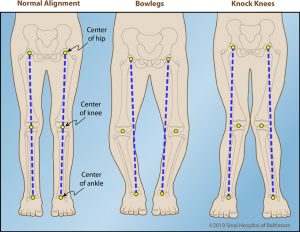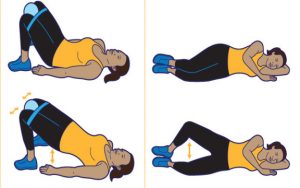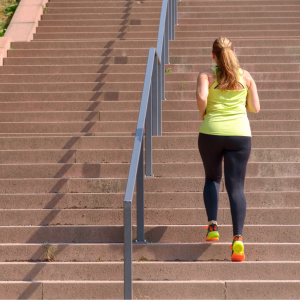Do you experience pain in your knees when walking UP the stairs?
The most common cause of knee pain when climbing stairs is a reduction in the cartilage of the knee.
The main functions of cartilage include cushioning forces and promoting smooth movements at joint. In the case of the knee, one of the key roles of cartilage is to maintain the position and movement of the patella, commonly known as the kneecap. When there is a breakdown of cartilage, it is common for the patella to move around where it shouldn’t, which can contribute to knee pain. A reduction in cartilage also means less cushioning of the forces through the knee – you may notice this more when climbing steps compared to walking on the flat ground, due to the extent the knee bends during stairs!
What should I look out for when climbing stairs? 
-
- Proper alignment of the leg: while the cartilage may not be aiding in the positioning of the patella, our muscles can. Try ensuring that there is a straight line travelling down from your hip, through your knee to your foot. This is likely to make a difference if your knees tend to drift inwards!
- Foot placement: we may not think much about our foot placement while walking but when ascending stairs, we should aim to have the whole foot on the step rather than just the toes/ball of our foot. This provides more stability through the ankle and can help to limit unwanted movement at the knee. Having our heel on the step also ensures we can push through the heel to lift, which recruits your powerful glute muscles to do the hard work!
Have a go at these exercises!
-
- Seated clam: start seated on a chair where your feet are together and able to touch the floor. From here, keep your feet together while you squeeze you buttock muscles and push your knees out to the side. Return your knees together and repeat.
- Sit to stand: start seated with your feet roughly shoulder width apart and your knees stacked over your ankles. Cross your arms across your chest and then stand. During this process try to focus on the path of your knees – do they stay inline or do they drift inwards?
Do you experience pain in your knees when walking DOWN the stairs?
When walking down stairs, there tends to be more impact through the knees as we typically ‘drop’ the last few centimetres as we descend!
If you experience pain when walking down the stairs but not up, there is a possibility that there is inflammation to one of the structures responsible for managing impact. In the knee, this is commonly bursitis. Bursa are fluid-filled sacks which cushion and absorb impact throughout the body. When irritated, bursa can become painful and often not perform this function well. They can also cause the knee to be swollen, red and hot to the touch. While in an irritated state, we should try to limit aggravating movements such as jumping or excessive repetitive movements like a long walk. Despite this, it is still important to keep moving and strengthening the muscles around the knee, and as the knee improves the types of exercises recommended will change to include more movement at the knee and repetition. It is important to note that there are many bursae around the knee, so if you experience these symptoms, you may like to see a health professional to work out which bursa is inflamed – this may also help in the prevention of future bursitis.
Have a go at these exercises!

-
- Isometric lying quad contraction: Begin lying on your back with legs flat. Contract the quadricep muscles (that run along the front of the leg above the knee) by pushing the knee down into the ground. Hold for 3-5 seconds and then relax. You will notice the there is no major movement here but the quadricep muscles are still working.
- Glute bridge: Begin lying on your back with knees bent and feet flat on the floor. Then, squeeze you buttock muscles and push your hips up off the ground. Hold for 1-2 seconds then slowly lower your hips back to the ground while continuing to squeeze the buttock muscles. This exercise will help to strengthen the buttocks, quadriceps and hamstrings all at once! If you experience cramping through the back of the legs try pushing through the heels and elevating your toes off the ground.

